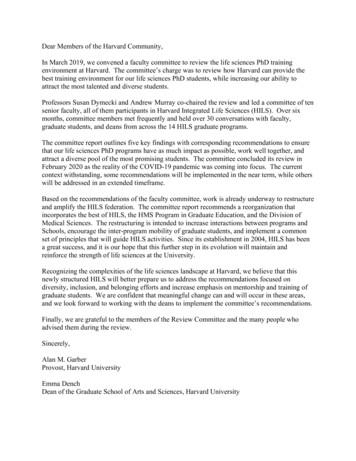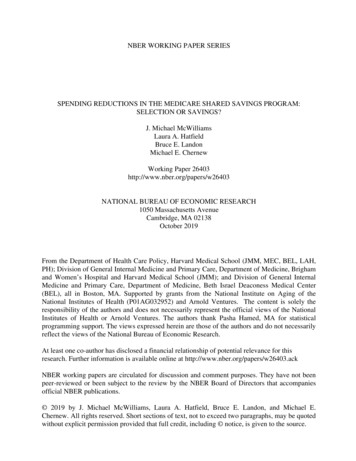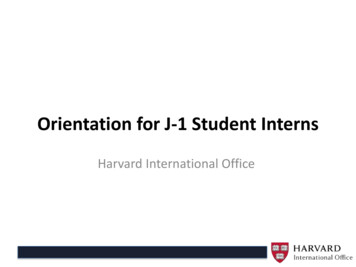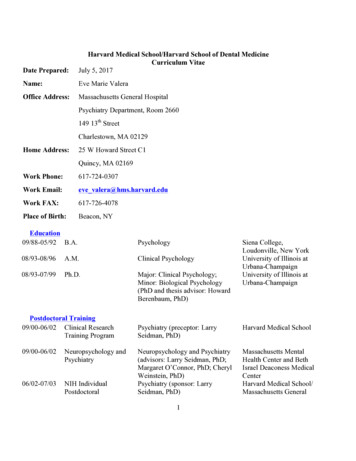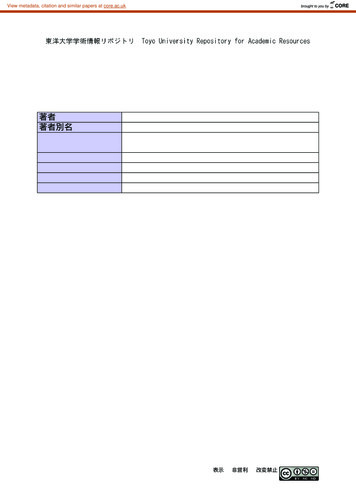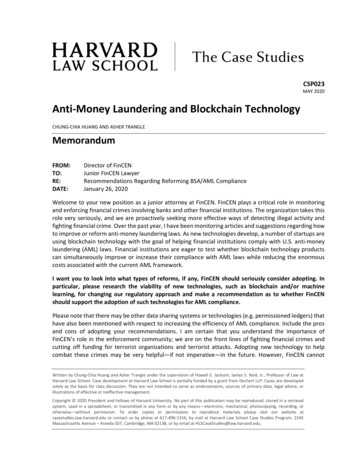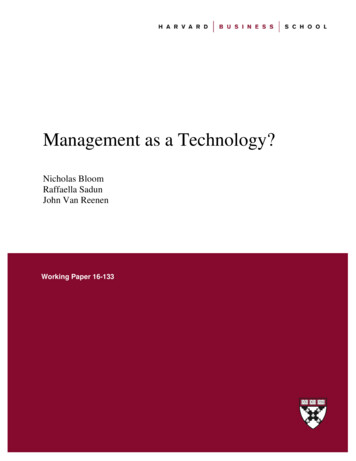
Transcription
Management as a Technology?Nicholas BloomRaffaella SadunJohn Van ReenenWorking Paper 16-133
Management as a Technology?Nicholas BloomStanford UniversityRaffaella SadunHarvard Business SchoolJohn Van ReenenMassachusetts Institute of TechnologyWorking Paper 16-133Copyright 2016, 2017 by Nicholas Bloom, Raffaella Sadun, and John Van ReenenWorking papers are in draft form. This working paper is distributed for purposes of comment and discussion only. It maynot be reproduced without permission of the copyright holder. Copies of working papers are available from the author.
MANAGEMENT AS A TECHNOLOGY? Nicholas Bloom (Stanford), Raffaella Sadun (Harvard), John Van Reenen (MIT, CEP)October 8, 2017AbstractAre some management practices akin to a technology that can explain firm and national productivity, or do they simply reflect contingent management styles? We collect data on coremanagement practices from over 11,000 firms in 34 countries. We find large cross-country differences in the adoption of management practices, with the US having the highest size-weightedaverage management score. We present a formal model of “Management as a Technology”,and structurally estimate it using panel data to recover parameters including the depreciationrate and adjustment costs of managerial capital (both found to be larger than for tangiblenon-managerial capital). Our model also predicts (i) a positive impact of management on firmperformance; (ii) a positive relationship between product market competition and average management quality (part of which stems from the larger covariance between management with firmsize as competition strengthens); and (iii) a rise in the level and a fall in the dispersion of management with firm age. We find strong empirical support for all of these predictions in our data.Finally, building on our model, we find that differences in management practices account forabout 30% of total factor productivity differences both between countries and within countriesacross firms.JEL No. L2, M2, O32, O33.Keywords: management practices, productivity, competition Acknowledgments: We would like to thank Ufuk Ackigit, Orazio Attanasio, Marianne Bertrand, Robert Gibbons,John Haltiwanger, Rebecca Henderson, Bengt Holmström, Michael Peters, Michele Tertilt and Fabrizio Zilibotti forhelpful comments as well as participants in seminars at the AEA, Barcelona, Berkeley, Birmingham, Bocconi, Brussels,CEU, Chicago, Dublin, Duke, Essex, George Washington, Harvard, Hong Kong, IIES, LBS, Leuven, LSE, Madrid,Mannheim, Michigan, Minnesota, MIT, Munich, Naples, NBER, NYU, Peterson, Princeton, Stockholm, Sussex,Toronto, Uppsala, USC, Yale and Zurich. The Economic and Social Research Council, the Kauffman Foundation,PEDL and the Alfred Sloan Foundation have given financial support. We received no funding from the globalmanagement consultancy firm (McKinsey) we worked with in developing the survey tool. Our partnership withPedro Castro, Stephen Dorgan and John Dowdy has been particularly important in the development of the project.We are grateful to Renata Lemos and Daniela Scur for ongoing discussion and feedback on the paper. Anna Valeroand Chiara Criscuolo have been generous in providing us with data. We thank Yo-Jud Cheng for excellent researchassistance. Any opinions and conclusions expressed herein are those of the authors and do not necessarily representthe view of the U.S. Census Bureau. All results have been reviewed to ensure that no confidential information isdisclosed.1
1IntroductionProductivity differences between firms and between countries remain startling. For example, withinthe average four-digit U.S. manufacturing industries, Syverson (2011) finds that labor productivityfor plants at the 90th percentile was four times as high as plants at the 10th percentile. Even aftercontrolling for other factors, Total Factor Productivity (TFP) was almost twice as high. Thesedifferences persist over time and are robust to controlling for plant-specific prices in homogeneousgoods industries.1 Such TFP heterogeneity is evident in all other countries where data is available.2One explanation is that these persistent within industry productivity differentials are due to “hard”technological innovations, as embodied in patents or the adoption of advanced equipment. Anotherexplanation, which is the focus of this paper, is that productivity differences reflect variations inmanagement practices.We advance the idea that some forms of management practices are like a “technology”, in thesense that they raise TFP. This has a number of empirical implications that we examine and findsupport for in the data. Our perspective on management is distinct from the common “Design”paradigm in organizational economics, which views management as a question of optimal designdepending on the very contingent features of a firm’s environment (Gibbons and Roberts, 2013).In this view of management practices, there is no sense in which any management styles are onaverage better than any others. Our data provides some support for Design perspective, but weshow that–at least within the very stylized version of this perspective that we consider–this deliversonly a partial explanation of the patterns that we can observe in our data.To date, empirical work to measure differences in management practices across firms and countrieshas been limited. Despite this lack of data, the core theories in many fields such as internationaltrade, labor economics, industrial organization and macroeconomics are now incorporating firmheterogeneity as a central component.3To address the lack of management data, we collect original survey data on management practiceson over 11,000 firms in 34 countries. Besides its rich cross sectional nature, both in terms of countriesand industries covered, this dataset also features a significant panel component built through four1These are revenue based measures of TFP (“TFPR”) so will also reflect firm-specific mark-ups. Foster, Haltiwanger and Syverson (2008) show large differences in TFP even within very homogeneous goods industries such ascement and block ice where they can observe plant specific prices (“TFPQ”). In what follows we will refer simply toTFP acknowledging that empirical measures usually be TFPR. König, Lorenz and Zilibotti (2016) give an exampleof how these could reflect technology differences even for ex ante identical firms. Hall and Jones (1999) show howthe stark differences in productivity across countries account for a substantial fraction of the differences in averageincome.2Usually productivity dispersion is even greater than in the U.S.–see Bartelsman, Haltiwanger and Scarpetta(2013), Hsieh and Klenow (2009) and OECD (2016).3Different fields have different labels for what we regard as heterogeneity in management. In trade, the focus is onan initial productivity draw when the plant enters an industry that persists over time (e.g. Melitz, 2003). In industrialorganization, the focus has traditionally been on cost heterogeneity due to entrepreneurial/managerial talent (e.g.Lucas, 1978). In macro, organizational capital is sometimes related to the firm specific managerial know-how built upover time (e.g. Prescott and Visscher 1980). In labor, there is a growing focus on how the wage distribution requiresan understanding of the heterogeneity of firm productivity (e.g. Card, Heining and Kline, 2013).2
different survey waves from 2004 to 2014. One purpose of this paper is to provide public use datato enable other researchers to address long-standing questions regarding firm organization.4 Wefirst present some stylized facts from this database in the cross country and cross firm dimensions.One of the striking features of the data is that the average management score, just like TFP, ishigher in the U.S. than it is in other countries (see Figure 1). A second striking feature is thatmanagement, like TFP, shows a wide dispersion across firms within each country (see Figure 2).Interestingly, this dispersion is lower in countries like the U.S., with lower levels of market frictions,than it is in countries like India and Brazil.We detail a simple model of “Management As a Technology” (MAT) which incorporates botha heterogeneous initial draw of managerial ability when a firm starts up, and the endogenousresponse of ongoing firms who change their level of managerial capital in response to shocks tothe environment (modeled as as idiosyncratic TFP shocks). The model is useful to formalize ourtheoretical intuitions and enable structural estimation of key parameters. In particular, thanksto the panel variation present in the management data, we are able to identify the depreciationrate and adjustment costs of managerial capital, using Simulated Method of Moments (SMM). Afurther benefit of the structural model is that it enables us to derive some additional predictionson moments we did not target in the structural estimation.We find that the data supports the predictions from the MAT model. First, management is positively associated with improved firm performance (productivity, profitability and survival) and,from experimental evidence, the management effect appears to be causal. Second, firm management rises with more intense product market competition, both through reallocating more economicactivity to the better managed firms (an Olley and Pakes (1996) covariance term), and also througha higher unweighted average level of management. Third, older firms have a higher level of management, but lower dispersion due to selection effects. We contrast our MAT model to the predictionsarising from a very stylized version of the “Management by Design” model, an alternative approach which sees management as a contingent feature, rather than an output-increasing factor ofproduction. There are some elements consistent with this second design approach, especially whenwe disaggregate the management score into elements relating to monitoring compared relative toincentives. However, overall the MAT model seems a better description of our data.Finally, using our MAT model we show that on average just under a third of cross country TFPdifferences with the U.S. are accounted for by management, with this fraction being higher inOECD countries than in less developed nations. Thus, management practices can account for asubstantial portion of cross-country differences in development. Similarly when we look withincountries, about 30% of the 90-10 difference in productivity between firms is accounted for bydifferences in management practices.In summary, this paper makes three major contributions over the existing literature. First, it4The methods and data are open source and available on our website ad-data/.3
develops and structurally estimates a model of management practices in the production function.Second, it uses this model to determine the extent to which management can account for variationsin productivity across firms and across a large number of countries. Finally, it produces a set ofPublic Use Micro Data which should facilitate future quantitative research in the area of managerialand organizational economics.Our paper relates to several literatures. First, there is a large body of empirical literature on theimportance of management for variations in firm and national productivity, going back to Walker(1887) through to more recent papers like Ichniowski, Shaw and Prennushi (1997), Bertrand andSchoar (2003), Adhvaryu, Kala and Nyshadham (2016) and Bruhn, Karlan and Schoar (2016).Second, there is a growing macro literature on aggregate implications of firm management andorganizational structure, ranging from Lucas (1978), to Gennaioli et al (2013), Guner and Ventura(2014), Garicano and Rossi-Hansberg (2015) and Akcigit, Alp and Peters (2016). Third, thereis a long literature on the causes of the slow diffusion of new technologies and the implicationsfor productivity differences (e.g. Griliches, 1957; Gancia, Mueller and Zilibotti, 2013). Finally,there is another growing literature focusing on explaining cross-country TFP in terms of the degreeof reallocation of inputs to more productivity firms, most notably Hsieh and Klenow (2009) andRestuccia and Rogerson (2008).The structure of the paper is as follows. We first describe some theories of management (Section2) and implements our structural approach. Section 3 describes the data and Section 4 detailsour empirical results. Section 5 uses the framework to quantify the degree to which managementcan account for the cross country and within country dispersion of productivity and Section 6offers some concluding comments. The online Appendices describe the data and how it can beaccessed (A), further econometric analysis (B), details of the SMM procedure (C) and the CEOcompensation data (D).22.1Models of ManagementConventional approaches to modeling heterogeneity in firm productivityEconometricians have often labeled the fixed effect in panel data estimates of production functions“management ability”. For the most part, however, economists have focused on how technologicalinnovations influence growth; for example, correlating TFP with observable innovation indicatorssuch as Research and Development (R&D), patents, or information technology (IT). There is robustevidence of the impact of such “hard” technologies for productivity growth (e.g. Griliches, 1998).Nevertheless, there are at least two major problems in focusing on these aspects of technical changeas the sole driver of productivity. First, even after controlling for a wide range of observablemeasures of hard technologies, a large residual in measured TFP still remains. Second, manystudies have found that the impact of technology on productivity varies widely across firms and4
countries. In particular, information technology has much larger effects on the productivity of firmsthat have complementary managerial structures which enable IT to be more efficiently exploited.5Furthermore, a large body of case study work also suggests a major role for management in raisingfirm performance (e.g. Baker and Gil, 2013).In light of these issues, we believe it is worth directly considering management practices as anindependent factor in raising productivity.2.2Formal models of managementIt is useful to analytically distinguish between two broad approaches that we can embed in a simpleproduction function framework where value added, Y, is produced as follows:e L, K, M )Y F (A,(1)e is an efficiency term, labor is L, non-management capital is K, and M is managementwhere Acapital.We begin with the “Management as Technology” perspective, where some types of management (orbundles of management practices) enhance productivity for the average firm across a wide rangeof environments. There are three types of these “best practices”. First, there are some practicesthat have always been better (e.g. not promoting incompetent employees to senior positions, orcollecting some information before making decisions). Second, there may be genuine managerialprocess innovations (e.g. Taylor’s Scientific Management; Lean Manufacturing; Deming’s TotalQuality Management, etc.). Third, many management practices may have become optimal due tochanges in the economic environment over time. Incentive pay may be an example of this, as theincidence of piece rates declined from the late 19th century, but appears to be making a comebacktoday.6The alternative framework is the more traditional approach in Organizational Economics whichwe label the “Management by Design” perspective, where differences in practices are simply stylesoptimized to a firm’s environment. For any indicator of M, such as the measures we gather,the Design approach would not assume that output is monotonically increasing in M. In somecircumstances, higher levels of what we would regard as good practices will explicitly reduce output.To take a simple example, consider M as a discrete variable which is equal to one if promotion takes5In their case study of retail banking, for example, Autor et al (2002) found that banks who failed to re-organizethe physical and social relations within the workplace reaped little reward from their adoption of IT. More generally,Bresnahan, Brynjolfsson and Hitt (2002) found that decentralized organizations tended to enjoy a higher productivitypay-off from IT across a wide range of sectors. Similarly, Bloom, Sadun and Van Reenen (2012) found that ITproductivity was higher for firms with stronger incentives management, using some of the measures we detail belowin Section 3.6Lemieux, MacLeod and Parent (2009) suggest that this may be due to advances in IT. Software companies likeSAP have made it much easier to measure output in a timely and robust fashion, making effective incentive payschemes easier to design and implement.5
into account effort and ability and zero otherwise (e.g. purely seniority based promotions). TheDesign perspective could find that pure tenure-based promotion, which ignores effort and ability,increases output in some sectors, for example by reducing influence activities (Milgrom, 1988),but increases it in others. Under the Design approach, the production function can be writtenas equation (1), but for some firms and practices F 0 (M ) 0. Even if M were costless, outputwould fall if it was exogenously increased. The Design approach emphasizes that the reason forheterogeneity in the adoption of different practices is that firms face different environments. Thisis in the same spirit as the “contingency” paradigm in management science (Woodward, 1958).The Design and the Technology perspectives can be nested within a common basic set-up but have,as we show, very different theoretical and empirical implications. Leaving aside for the moment thespecific modeling choice of F (M ), we formalize these ideas by treating M as an intangible capital(as in Corrado and Hulten, 2010), which has a market price and also a cost of adjustment. Weallow firms to have an exogenous initial draw of M when they enter the economy. This creates exante heterogeneity between firms (generalizing the approach in Hopenhayn, 1992, for TFP). Factorinputs and outputs are firm specific (we do not use t subscripts for simplicity unless needed). Weconsider a single industry, so firm-specific values are indicated by an i subscriptfi K α Lβ G(Me i)Yi Ai i(2)e i ) is a management function common to all firms. Demand is assumed to derive fromwhere G(Ma final good sector (or equivalently a representative consumer) using a CES aggregator acrossindividual inputs:Y N11 ρNXYiρ 1ρρ! ρ 1(3)i 11where ρ 1 is the elasticity of substitution, N is the number of firms and N 1 ρ is the standardadjustment factor to make the degree of substitution scale free (e.g. Alessandria and Choi, 2007).Applying the first order conditions gives each firm an inverse demand curve with elasticity ρ wherewe have normalized the industry price to be P 1Pi ( 1Y ρ1 1) Yi ρ BYi ρN(4)1ρYwhere the demand shifter is B ( N) . These production and demand curves generate the firm’srevenue function:Pi Yi Ai Kia Lbi G(Mi )1fi 1 1/ρ ( Y ) ρ , a α(1 1/ρ), b β(1 1/ρ)where for analytical tractability we defined Ai ANe i )(1 1/ρ) . Profits, defined as revenues less capital, labor and management costsand G(Mi ) G(M6
(cK (K), cL (L) and cM (M )), and fixed costs F are:7Πi Ai Kia Lbi G(Mi ) cK (Ki ) cL (Li ) cM (Mi ) F2.3Models of management in productionIn terms of the management function G(Mi ), we consider two broad classes of models. First,Management as a Technology where management is an intangible capital input in which outputis monotonically increasing. Second, Management by Design in which management is a choice ofproduction approach. We focus on the first as this fits the data better (as we show below), but layout both approaches in what follows.2.3.1Management as a Technology (MAT)In Lucas (1978) or Melitz (2003) style models, firm performance is increasing continuously inthe level of managerial quality, which is synonymous with productivity. Firms draw a level ofmanagement quality when they are born, and this continues with them throughout their lives.Since these types of models assume G(Mi ) is increasing in Mi , we simplify the revenue function byassuming G(Mi ) MicPi Yi Ai Kia Lbi Mic(5)More generally, we want to allow for the possibility that management can also be endogenouslyimproved; for example, by hiring management consultants, spending time developing or reinforcingimproved organizational processes (e.g. Toyota’s Kaizen meetings), or paying for a better CEO.Although managerial capital can be improved in this way, failure to invest may mean it depreciatesover time like other tangible and intangible assets such as physical capital, R&D, and advertising.Hence, we set up a more general model which still has initial heterogeneous draws of managementwhen firms enter, but treats management as an intangible capital stock with depreciation:Mit (1 δM )Mit 1 IitMIitM 0(6)where IitM reflects investment in management practices, which has a non-negativity constraintreflecting the fact that managerial capital cannot be sold. The physical capital accumulationequation is similar except it allows for capital resale (at a cost which we discuss later).Kit (1 δK )Kit 1 IitK7(7)Since firms in our data are typically small in relation to their input and output markets, for tractability we ignoreany general equilibrium effects, taking all input prices (for capital, labor and management) as constant.7
2.3.2Management by DesignAn alternative approach is to assume that management practices are contingent on a firm’s environment, so that increases in M do not always increase output. In some sectors, high values of Mwill increase output, and in others they will reduce output depending on the specific features of theindustry. We assume that optimal management practices may vary by industry and country, butthis could also occur across other characteristics like firm age, size, or growth rate. For example,industries employing large numbers of highly skilled employees, like pharmaceuticals, will requirelarge investments in careful hiring, tying rewards to performance and monitoring output, whilelow-tech industries can make do without these costly human resource practices. Likewise, optimalmanagement practices could vary by country if, for example, some cultures are more comfortablewith firing persistently under-performing employees (e.g. the U.S.) while others emphasize loyaltyto long-serving employees (e.g. Japan).There are many ways to set up a Design model. As a simple example we define G(Mi ) 1/(1 θ Mi M ) where θ 0 and G(Mi ) (0, 1] is decreasing in the absolute deviation of M from itsoptimal level M .8 There are of course many other ways to model this idea, and our approach iscertainly not meant to represent the wide range of Design approaches, rather we see it as a simplee i ) function which attains an interior maximum.example to illustrate the implications of a G(M2.3.3Management as Capital?We initially debated calling our main approach “Management as Capital” (rather than “Management as a Technology”), viewing management as an intangible capital stock (see for example Bruhn,Karlan and Schoar, 2016). In the end, because of the evidence suggesting management spilloversacross plants within firms and between different firms9 we thought modeling management as a technology seemed more appropriate. However, we recognize that either terminology could be used.Indeed, the classic technology input–the R&D knowledge stock–is recorded as an intangible capitalinput by the Bureau of Economic Activity in U.S. National Accounts.2.4Adjustment costs and dynamicsIn general, changing a capital stock will involve adjustment costs. This could reflect, for example,the costs of the organizational resistance to new management practices (e.g. Cyert and March, 1963,or Atkin et al., 2017). We assume changing management practices involves a quadratic adjustmentcost:CM (Mt , Mt 1 ) γM Mt 1 (8 Mt δM )2 MMt 1Our baseline case also assumes that M is a choice variable that does not have to be paid for on an ongoing basisso that δM 0 although this assumption is not material.9For example, Greenstone, Hornbeck and Moretti (2010), Atalay, Hortascu and Syverson (2014), Braguinsky etal. (2015) and Bloom et al. (2017).8
where the cost is proportional to the squared change in management net of depreciation, and scaledby lagged management to avoid firms outgrowing adjustment costs. This style of adjustment costs iscommon for capital (e.g. Chirinko, 1993) and seems reasonable for management where incrementalchanges in practices are likely to meet less resistance than large changes. Likewise, we also assumesimilar quadratic adjustment costs for non-managerial capital:CK (Kt , Kt 1 ) γK Kt 1 (Kt Kt 1 δK )2 It (1 φK D(It 0))Kt 1where It is the investment rate, φK is the resale loss on capital and D(It 0) is an indicator functionfor disinvestment. To minimize on the number of state variables in the model, we assume labor iscostlessly adjustable, but requires a per period wage rate of w. Given this assumption on labor,we can define the optimal choice of labor by P Y (A,K,L ,M ) L w. Imposing this labor optimalitycondition and assuming the MAT specification for management in the production function, weobtain:acY (A, K, M ) A K 1 b M 1 bb1where A b 1 b A 1 b .10 . Finally, ln(A) is assumed to follow a standard AR(1) process so thatln(Ait ) lnA0 ρA ln(Ai,t 1 ) σA εi,t where εi,t N (0, 1). This will generate the firm-specificdynamics in the model, which alongside the random initial draw for management, which generatethe stochastics in our model.2.5Optimization and equilibriumGiven the firm’s three state variables–business conditions A, capital K, and management M –wecan write a value function (dropping i -subscripts for brevity):V (At , Kt , Mt ) max[V c (At , Kt , Mt ), 0]V c (At , Kt , Mt ) maxKt 1, Mt 1[Yt wL CK (Kt 1 , Kt ) CM (Mt 1 , Mt ) F rEt V (At 1 , Kt 1 , Mt 1 )]where the first maximum reflects the decision to continue in operation or exit (where exit occurswhen V c 0, the value for “continuers”) , the V c second is the optimization of capital and management conditional on operation, and r is the discount factor. We assume there is a continuum ofpotential new entrants that would have to pay one period of fixed costs F to enter.11 Upon entry,they take a stochastic draw of their productivity (A) and management (M ) from a known jointdistribution H(A, M ) and start with non-managerial capital K0 0. Hence, entry occurs until the10We define the units for labor, management and capital so that their prices are unity.We can allow the entry sunk cost to be different from a one period fixed cost as in Bartelsman et al (2013). Inan earlier version of the paper we used firm level exit rates to estimate sunk costs and generated qualitatively resultsto those presented below. Since nothing in the results hinges on this, we kept the current set-up for simplicity.119
point that the expected value of entry equals the sunk cost of entry:ZF V (A, 0, M )dH(A, M )1ρYWe solve for the steady-state equilibrium by selecting the demand shifter (B ( N) ) that ensuresthat the expected cost of entry equals the expected value of entry given the optimal capital andmanagement decisions. This equilibrium is characterized by a distribution of firms in terms of theirstate values A, K, M . The distribution of lnA is assumed normal, while M is assumed to be drawnfrom a uniform distribution.122.6Numerical EstimationAppendix C discusses this in more detail. In short, solving the model requires finding two nestedfixed-points.13 First, we solve for the value functions for incumbent firms using the contractionmapping (e.g. Stokey and Lucas, 1986), taking demand as given for each firm. The policy correspondences for M and K are formed from the optimal choices given these value functions, andfor L from the static first-order condition. Second, we then iterate over the demand curve (3) tosatisfy the zero-profit condition.14 Once both fixed points are satisfied, we simulate data for 5,000firms over 50 years to get to an ergodic steady-state, and then discard the first 40 periods to keepthe last 10 years of data (to match the time span of our management panel data).To solve and simulate this model we also need to define a set of 14 parameter values. We pre-definenine of these from from accounting measurement (e.g. the labor share of GDP, the depreciation rateon capital) or estimates in the prior literature, we normalize two (fixed costs to 100 and the meanof ln(TFP) to 1) and estimate the remaining three parameters on our management and accountingdata panel. The nine predefined parameters are listed in Table 1, and are all based on standardvalues in the literature. Appendix C describes how we cross-checked these calibration values withour own WMS data. For example, the Cooper and Haltiwanger (2006) estimates of the standarddeviation (σA ) and auto-correlation of TFP (ρA ) implicitly include managerial capital (M ), whichwe can observe in our data. The three unknown parameters that we choose to estimate are thosewhere much less is known from the literature. The adjustment cost (γM ) and depreciation rates(δK ) for management have never been estimated before, to our knowledge. We also estimate theadjustment cost for non-managerial capital (γK ). While prior papers have estimated labor andcapital adjustment costs (e.g. Bloom, 2009, and the survey therein), they have typically ignoredmanagement as an input, so it is these parameters are not directly transferable to our set-up.12Nothing fundamental hinges on the exact distributional assumptions for M and A.T
management, like TFP, shows a wide dispersion across rms within each country (see Figure 2). Interestingly, this dispersion is lower in countries like the U.S., with lower levels of market frictions, than it is in countries like India and Brazil. We detail a simple model of \Management As a Technology" (MAT) which incorporates both

